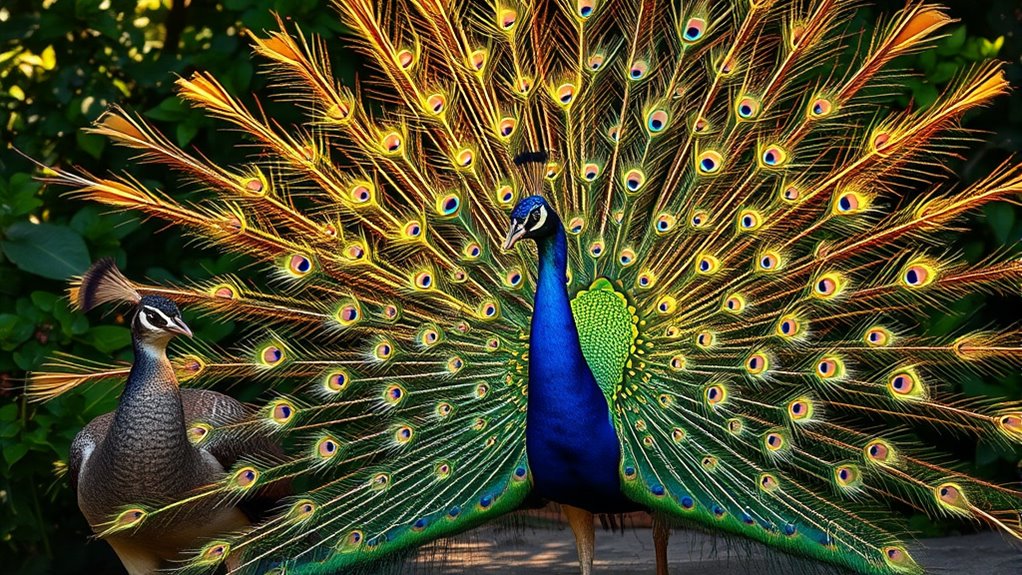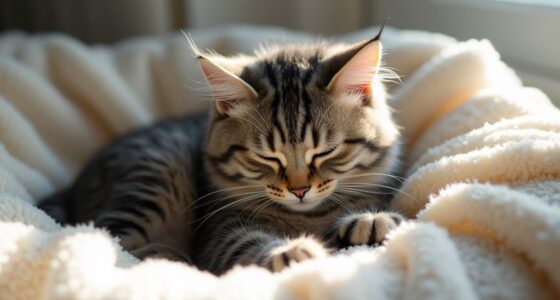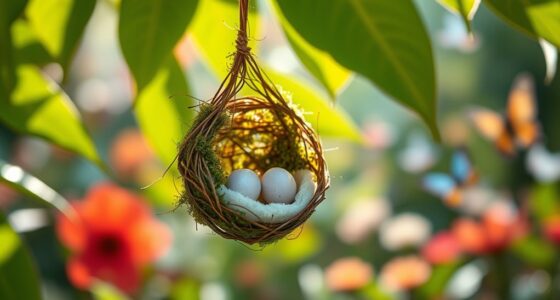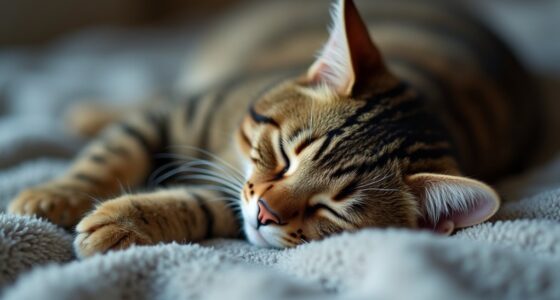Courtship displays are crucial for how animals choose mates. Creatures often showcase their fitness through vibrant colors, intricate dances, and unique vocalizations. For instance, bright plumage or energetic movements signal health and vitality, catching the attention of potential partners. These displays not only attract mates but also deter rivals, showcasing the individual’s strength and suitability. If you’re curious about the specific tactics animals use in these enthralling courtship rituals, there’s so much more to explore!
Key Takeaways
- Courtship displays showcase individual fitness and health to attract potential mates through visual signaling and intricate rituals.
- Bright plumage and elaborate dances signal genetic quality and vitality, influencing mate selection in various species.
- Vocal calls and acoustic signals communicate strength and health, helping to attract females and deter rivals.
- Behavioral rituals, including synchronized movements and gift presentations, demonstrate suitability as a mate and caregiver.
- Animal courtship displays parallel human attraction methods, highlighting the universal principle of showcasing qualities for mate selection.
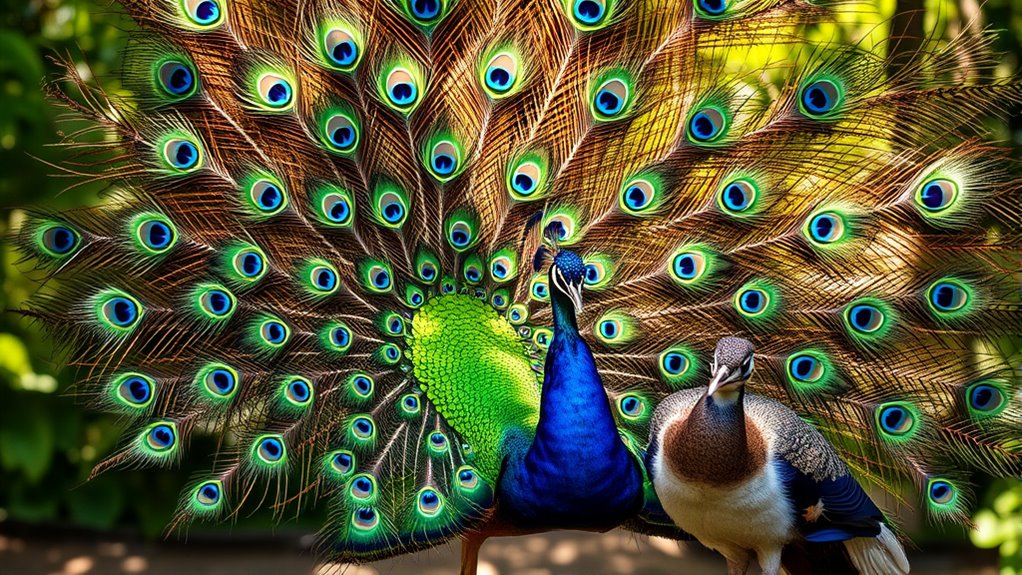
Have you ever wondered how animals attract their mates? The world of courtship displays is nothing short of fascinating. You’ll find that many species use a combination of visual signaling and behavioral rituals to catch the eye of potential partners. These displays not only showcase an individual’s fitness but also communicate important information about their health and genetic quality.
Animals employ captivating courtship displays, blending visual signals and rituals to attract mates and convey their fitness and genetic quality.
Take, for instance, the vibrant plumage of peacocks. When a male spreads his tail feathers, it’s more than just a pretty sight; he’s using visual signaling to demonstrate his vitality. The brighter and more extensive the feathers, the healthier he likely is. As you observe this display, you can’t help but notice how the female peahens respond, drawn to the most impressive males. It’s a dance of attraction, where each flourish of feathers serves as an invitation to mate.
In addition to visual signaling, behavioral rituals come into play. Many animals engage in intricate dances or movements to woo potential mates. For example, some species of birds perform elaborate courtship dances that involve synchronized movements, calls, and even the presentation of gifts. You might watch a male bird hop and flutter around, showcasing not just his physical attributes but also his agility and energy. It’s a way for him to prove he’s not only a good mate but also capable of contributing to the survival of their future offspring.
These rituals can get quite elaborate. Some frogs, for instance, have unique vocal calls that not only attract females but also deter competitors. The volume and frequency of their croaks can signal their health and strength. When you hear one of these calls in the wild, you realize it’s more than just noise; it’s a carefully crafted message aimed at securing a mate.
As you observe these courtship displays, you might find yourself reflecting on the parallels to human relationships. Just like animals, humans often put their best foot forward when trying to attract a partner. Whether it’s through dressing well, showcasing talents, or engaging in charming behaviors, we too rely on visual and behavioral cues to make connections.
In the end, courtship displays are a beautiful blend of nature’s artistry and survival instincts. By understanding these displays, you gain insight into the complex world of animal behavior and the timeless dance of attraction that spans across species.
Frequently Asked Questions
Do Courtship Displays Vary by Species or Habitat Type?
Yes, courtship displays do vary by species and habitat type. You’ll notice display diversity as animals adapt their behaviors to thrive in different environments. For instance, bright colors might attract mates in lush forests, while subtle movements could be more effective in open grasslands. These adaptations guarantee that each species uses its unique display to communicate effectively, increasing their chances of successful mating in their specific habitats.
How Do Environmental Factors Influence Courtship Behaviors?
Environmental factors shape courtship behaviors like a sculptor chiseling stone. Climate change warms habitats, shifting food availability and mating seasons, while habitat destruction carves out safe spaces. You’ll notice that animals adapt their displays to survive in these altered landscapes, often becoming more vibrant or elaborate in response to stress. These changes can lead to new mating strategies, as they navigate the challenges of a world increasingly transformed by human impact.
Are Courtship Displays More Common in Certain Animal Groups?
Yes, courtship displays are more common in certain animal groups, especially those where sexual selection plays a significant role. Birds, for instance, often exhibit complex displays that showcase their fitness and attract mates. These displays vary in complexity, ranging from elaborate dances to vibrant plumage. In contrast, some species may rely less on visual displays, focusing instead on sounds or scents. Overall, the diversity of courtship behaviors reflects the unique pressures of sexual selection within each group.
Can Courtship Displays Evolve Over Time Within a Species?
Yes, courtship displays can evolve over time within a species. As sexual selection pressures change, certain traits become more desirable. You might notice that displays can shift in complexity or style, adapting to attract mates more effectively. These changes often arise from environmental factors or shifts in mate preferences. By observing these evolutions, you can gain insight into how species adapt and thrive through their unique display evolution strategies.
How Do Predators Affect the Success of Courtship Displays?
Predators can considerably impact the success of courtship displays. When you’re trying to attract a mate, predator distraction can divert attention, making it harder for you to showcase your traits. Animals often adapt by employing display concealment, hiding their displays to protect themselves while still communicating with potential partners. This strategy helps reduce the risk of predation, allowing you to find a mate while minimizing danger during those critical moments of attraction.
Conclusion
In the fascinating world of courtship displays, you’ve seen how animals use vibrant colors, intricate dances, and elaborate calls to attract mates. These rituals not only guarantee the continuation of their species but also highlight the beauty of nature’s diversity. As you observe these enthralling behaviors, you might wonder: what can we learn about attraction and connection in our own lives? By appreciating these displays, you gain insight into the delicate balance of life and love in the animal kingdom.
